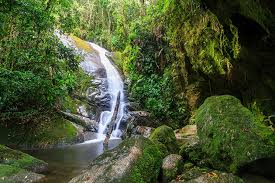ENVIRONMENT: The Emeraald Forest – more than trees

By Jonathan Power
Belem is the Brazilian city at the mouth of the Amazon. Unlike its slummy counterpart, Kinshasa, at the mouth of the Congo, it’s full of resplendent streets with beautiful nineteenth-century houses. It has squares and market places full of cafes, fountains, and life.
The large city grew up shipping rubber from the Amazon forest, which begins on its doorstep. This made it wealthy. One can see the beautiful baroque Theatre of Peace, a fluffy pink building where Anna Pavlova danced. On the main square, ornate with pavements of black and white quartz, is the Hotel Grao Para where Xavier Cugat and his orchestra would play and Zsa Zsa Gabor would stopover on her way, by propeller plane, on the slow flight to Rio. Then there is the magnificent opera house which once attracted the best singers from Europe and North America. Now beautifully restored it is attempting to do the same again.
By now we all know the forest has been milked of much of its wealth and, as wildfires sweep across its mammoth area, cattle farming and illegal logging are having a field day under the very right-wing president, Jair Bolsonaro, who is tearing apart the legacy of the great conservationist, the now-imprisoned, ex-president, Luis Ignacio Lula da Silva.
Less well known is that it is now 50 years since Pierre Gourou in his seminal book, “Le Monde Tropique”, warned that the tropical forest is not, as it appears, a farmers’ and ranchers’ paradise. It’s a fragile environment and only the Indians, with their shifting cultivation, have fully come to terms with it- farming in a way that protects and preserves the forest.
Cutting such a forest down- it is the same in the Congo, Indonesia, India, Madagascar and China- and introducing modern methods of intensive agriculture or cattle-rearing leads to its ruin. Without the protective cover of the umbrella canopy, the soil will turn soon enough to rock, laterite or sand. Yet still, the lesson is unlearned. Within a few hours drive from Belem along forest back-roads, but well within reach of the local administration, one can see new attempts at large-scale forest clearing, as settlers from Brazil’s central, north-eastern and southern states attempt to develop pasture for cattle. Every minute of the day three football pitches of forest are cleared away.
John Boorman’s great piece of cinema, “The Emerald Forest” portrayed the magnificence of Amazonas. Made 35 years ago it warned us that the forest was rapidly disappearing. Boorman was the David Attenborough of his time. He wasn’t listened to by enough people.
Wildfires
Still enormous, still overpowering, dense and in parts near-impenetrable, the jungle is being eaten into or burnt away too fast both for Brazil’s good and for mankind’s. It’s the planet’s largest lung, producing 30% of our planet’s oxygen supply and is one of the great repositories of plants that can produce some of our most important medicines.
The Amazon contains around one million forms of plant and animal life, 10% of the Earth’s stock of species. A single hectare of the rain forest can contain up to 230 species of tree compared with 10 to 15 normally found in temperate forests.
Tropical forests produce essential oils, gums, latexes, resins, tannins, steroids, waxes, edible oils and, above all, the raw material for medicines. More than 50% of modern medicines come from the natural world. For example, two important anti-cancer compounds are derived from the periwinkle plant found in the forests of Madagascar.
The synthesis of many naturally derived drugs is often enough not commercially feasible and even for those drugs that can be synthesized the chemical blueprints provided by wild plants are often needed.
The centers of origin of many food plants lie in the tropical forest. The world’s food supply depends on maintaining plant resistance to pests and diseases. Resistance is often maintained by crossbreeding with wild populations of the same species. Already too many wild food plant varieties have become extinct.
New breakthroughs also depend on the untouched stock of genes. The gene for the semi-dwarf variety of rice that over the last three decades has transformed Asian agriculture came from a primitive Taiwanese plant and its resistance to virus came from another wild species that probably evolved in the Silent Valley in India.
Reforesting
In the last few years, some countries have led the way in re-foresting vast areas. In Kenya, the late Wangari Maathai led a nation-wide movement of women to plant over 50 million trees. For this, she won the Nobel Peace Prize. Last month Ethiopia mobilized its people to plant 350 million trees in one day.
A little late, but it is not too late, the world is beginning to wake up to the importance of this heritage. The emerald forests need not die, but mankind must use its wit and will to save them.





